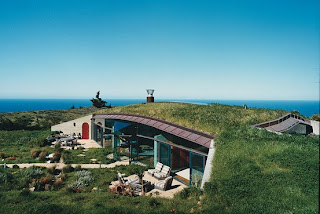I’m reading a book right now called The Worst Hard Time which is about the infamous Dust Bowl that hit the
Just as fascinating is the glimpse the author gives into the lives of these early settlers. They came to the area with next to nothing and were enticed by free land from the government and a false hope that the dry land could be farmed. But before they could begin to plow the land, they needed to create shelters. Since there were no trees to build log cabins, these farmers made their new homes out of prairie sod. These were known as dugouts and were typically carved out of the side of a hill. The roof, floor and three walls were made out of the earth and only the front facade was built with purchased materials. Obviously a shelter like this saved these poor farmers the major cost of building a more conventional home.



These farmers built these crude homes purely out of necessity. Aside from cost, there wasn’t too much desirable about a dugout back then. They were cramped, dark and dirty. But the principles of a house integrated with the earth have evolved into a method of sustainable architecture known today as “earth sheltering.”

The benefits of homes integrated with the land are great. These homes regulate temperature naturally by staying cool in the summer and maintaining heat in the winter.

















